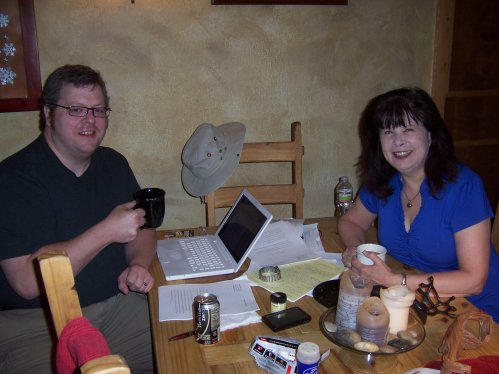Yes, last night was a gas. (Do people still say that?) It really was. And I didn’t much enjoy it.
Here’s the story: It was 6:45 PM. We were done with dinner, dishes washed, everything put away. I was back in my office and had begun to scan Facebook. I heard a noise. It sounded like one of the pop-up sprinkler risers when you first turn it on and water is driving the air out: A steady hiss, but loud. Anomalously loud; almost an embryonic roar. I was inside. The risers are all outside. I heard it very clearly. And so I went out the front door to take a look.
The roar was startling–at least on our quiet street, where almost any loud noise is startling. It was coming from the lowest level of the landscaping terraces to the south of our front door, right below my office windows, where the control box and pipes for the sprinkler system are located.
Something obviously broke somewhere. But where was the spraying water? I picked my way around the terraces and hopped down to the lowest level where the pipes were–and the reek of ethyl mercaptan almost knocked me over. The roar was coming from the street feed riser pipe where it met the gas meter. I passed my hand along the riser pipe and felt a strong jet of what suggested compressed air coming from the pipe joint at the meter. It took a moment for the truth to hit me: methane was roaring out of our gas feed at 30 PSI. I hadn’t smelled it because the wind was from the north and the gas meter is near the south end of the house.
The pipe looked as though someone had tried to cut it with a knife. It was still attached to the meter coupling but the metal had opened up where the threads began, to leave a gap at least 3/8″ wide. I only gave myself a second to think WTF? Then I remembered my father’s lessons. He worked for the Chicago natural gas utility his entire career, as an industrial engineer. He knew methane all the way down. He enjoyed ridiculing the vague statements in my kid astronomy books describing Jupiter’s atmosphere as consisting of “poisonous ammonia and methane gas.” Methane gas isn’t poisonous the way ammonia or even carbon monoxide is. However–it burns. That’s its job. Get enough of it in one place, and it blows up.
Carol had followed me out the door when I told her I thought the sprinkler system had erupted again. I called up from the terrace that we had a gas leak, a huge big honking might-as-well-be-an-open-pipe gas leak. I climbed back up the terrace walls in a helluva hurry, and while she threw leashes on the dogs I grabbed the cordless and dialed 911.
The call itself took maybe thirty seconds, and the operator handled it with an icy coolness that I greatly admire. She got the address and called the fire department. Then she told us to make sure no one was still in the house, and then move upwind of the leak by 300 feet.
We’re only a few blocks from the Farthing fire station. The truck was pulling up three minutes later. The firemen took one look at the leak (which you could hear over the rumble of the fire truck’s engine, egad) and started unrolling hoses over to the hydrant. That was a little unnerving, but one came over and explained: The pipe break was on the street side of the main, so flipping the shutoff valve on the gas meter would do nothing. They had already called for another truck with more specific equipment, but in the meantime they wanted hoses at ready in case the methane ignited.
We stood and watched. A second truck came by about ten minutes later, followed by a truck from the gas utility. They carefully cut the pipe (I couldn’t see precisely how it was done) and put a cap on it. They went through the house and opened all the windows. The fire trucks left soon after, but the utility techs worked until almost 11:00PM digging under the riser pipe to find the street feed. The riser has to be replaced, so there will be more digging. In the meantime, they ran a stiff coiled yellow plastic gas hose from the street side of our next-door neighbor’s gas meter.
So what happened? The utility guys had seen it before: The ground under the gas meter has been settling ever since we built the house eight years ago, pulling the natural gas riser pipe down with it. The gas meter was off-level, and has been for years. I never gave it much thought. The riser pipe pulled down on the gas meter until stresses on the riser pipe caused it to break at its thinnnest point, the threads.
We’ve had subsidence problems here for years. So not only did the settling destroy one sidewalk (which was replaced) and then mangled my driveway, it almost blew the place up. There’s a lesson here: If your gas meter isn’t level, the riser pipe may be pulling it down as the soil settles. If the riser is pulled downward enough, the pipe will crack. I’m a little amazed that the gas utility hasn’t publicized this problem more broadly.
Go take a look at your gas meter. If it’s cockeyed, the riser may be pulling one side of it down–and that leads to a species of fun you do not want to have!

















